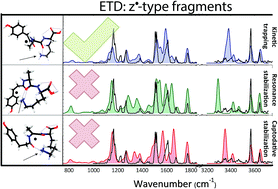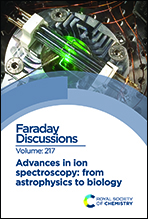Investigation of the position of the radical in z3-ions resulting from electron transfer dissociation using infrared ion spectroscopy†
Abstract
The molecular structures of six open-shell z3-ions resulting from electron transfer dissociation mass spectrometry (ETD MS) were investigated using infrared ion spectroscopy in the 800–1850 and 3200–3700 cm−1 spectral ranges in combination with density functional theory and molecular mechanics/molecular dynamics calculations. We assess in particular the question of whether the radical remains at the Cα-site of the backbone cleavage, or whether it migrates by H-atom transfer to another, energetically more favorable position. Calculations performed herein as well as by others show that radical migration to an amino acid side chain or to an α-carbon along the peptide backbone can lead to structures that are more stable, by up to 33 kJ mol−1 for the systems investigated here, by virtue of resonance stabilization of the radical in these alternative positions. Nonetheless, for four out of the six z3-ions considered here, our results quite clearly indicate that radical migration does not occur, suggesting that the radical is kinetically trapped at the site of ETD cleavage. For the two remaining systems, a structural assignment is less secure and we suggest that a mixture of migrated and unmigrated structures may be formed.

- This article is part of the themed collection: Advances in ion spectroscopy - from astrophysics to biology


 Please wait while we load your content...
Please wait while we load your content...